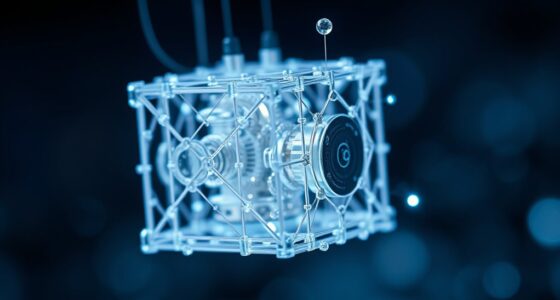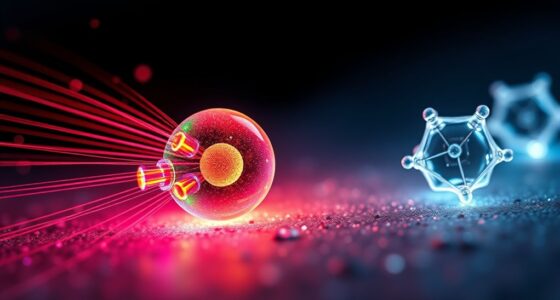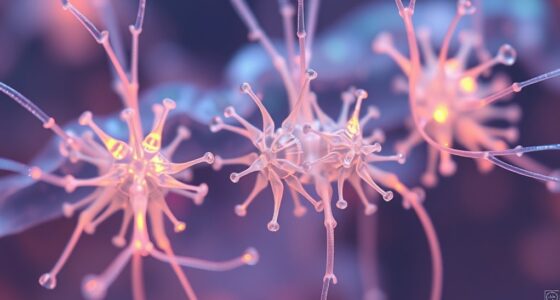Programming nanomachines with logic gates at the nanoscale involves designing molecular components like DNA, carbon nanotubes, or nanoparticles that perform Boolean functions such as AND, OR, and NOT. You can use self-assembly, advanced fabrication, and external stimuli like light or electric fields to create reliable, scalable logic circuits. This enables complex decision-making and processing at an incredibly small scale. Keep exploring to discover how these tiny devices will revolutionize technology.
Key Takeaways
- Molecular self-assembly techniques enable precise formation of nanoscale logic gates using DNA, proteins, or nanoparticles.
- External stimuli like light or electric fields activate or switch nanoscale logic components for desired operations.
- DNA origami and chemical synthesis are used to engineer specific molecular structures functioning as logic gates.
- Molecular interactions serve as switches, allowing implementation of Boolean functions (AND, OR, NOT) at the nanoscale.
- Integration of nanoscale sensors and logic elements facilitates autonomous decision-making in nanomachines.
Understanding the Basics of Nanomachines
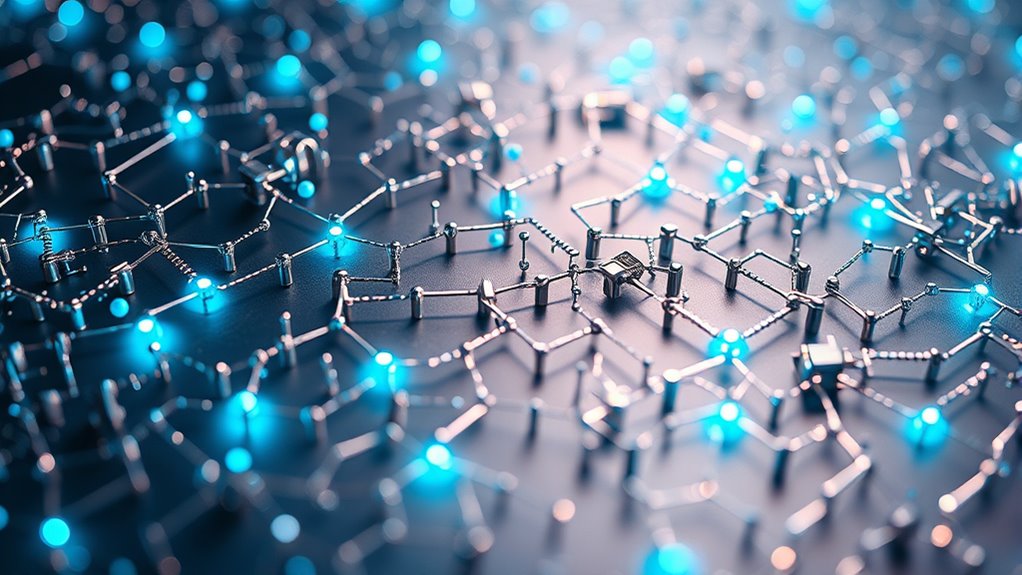
Nanomachines are tiny devices designed to perform specific tasks at the molecular level, often measuring less than 100 nanometers. You’ll find that they rely heavily on molecular motors, which generate movement or force, enabling tasks like transporting molecules or manipulating structures. Nanoscale sensors are integral components, allowing these machines to detect environmental changes, chemical signals, or mechanical forces with remarkable precision. By understanding these fundamental elements, you recognize how nanomachines can operate autonomously or under external control, executing complex functions at an incredibly small scale. Their design combines biological principles with engineered components, making them versatile tools for medicine, manufacturing, and scientific research. Understanding the role of power sources is crucial for advancing nanomachine functionality and efficiency. Mastering these basics lays the foundation for exploring how nanomachines can be programmed for specific, advanced applications.
Principles of Logic Gates and Their Significance
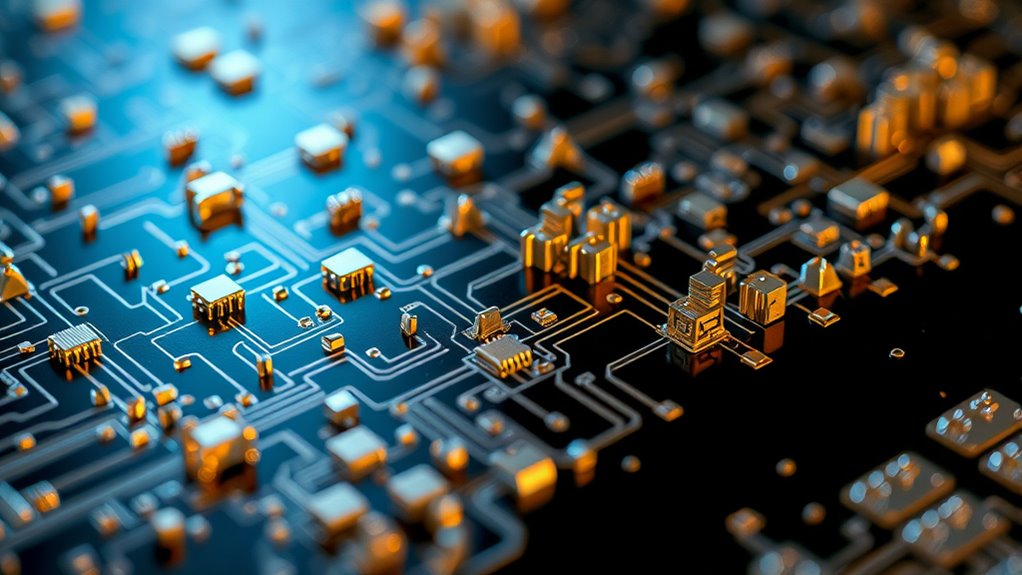
Understanding how nanomachines process information requires exploring the principles behind logic gates. Molecular logic forms the foundation, where tiny molecules act as switches responding to specific stimuli. These molecules perform Boolean functions, which are the basic operations of logic gates like AND, OR, and NOT. By manipulating molecular interactions, you can design nanoscale systems that process signals much like traditional electronic circuits. These molecular logic gates enable nanomachines to perform complex decision-making tasks, making them essential for advanced applications. Their significance lies in transforming simple molecular interactions into functional computational elements, allowing nanomachines to process information efficiently. Mastering these principles helps you develop more sophisticated nanoscale devices capable of performing logic operations at an unprecedented scale.
Materials and Methods for Building Nanoscale Logic Components

Building nanoscale logic components requires selecting materials that can reliably perform switching and signal transmission at an extremely small scale. You’ll often rely on molecular self-assembly, which uses natural interactions between molecules to form precise structures without complex manufacturing. This process allows you to create consistent, functional components at the nanoscale. Nanoscale fabrication techniques, such as electron beam lithography or chemical synthesis, help you shape and position materials with high accuracy. These methods enable the construction of intricate logic elements from materials like DNA, carbon nanotubes, or metal nanoparticles. By combining molecular self-assembly with advanced fabrication approaches, you can develop robust, scalable nanoscale logic components essential for building nanomachines. This foundation ensures your logic gates operate efficiently in the tiny domain of nanotechnology.
Techniques for Programming Nanomachines
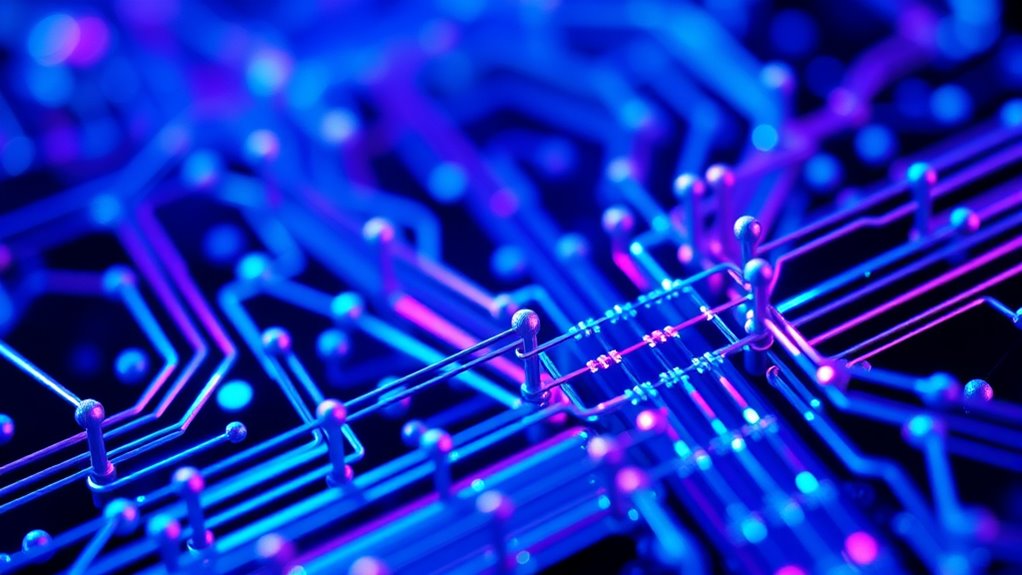
Programming nanomachines involves using precise techniques to control their behavior and functions at the molecular level. You can manipulate molecular assembly processes to build specific structures and pathways. Techniques like DNA origami enable you to create custom nanostructures by guiding molecular interactions. Controlling energy transfer is essential; you can direct how energy flows within nanomachines to activate or switch their logic functions. You might also use external stimuli, such as light or electric fields, to trigger molecular responses. These methods allow you to program nanomachines with high accuracy, ensuring reliable operation at the nanoscale. By combining molecular assembly with energy transfer control, you set the foundation for complex nanoscale logic operations—paving the way for advanced nanodevices.
Examples of Nanoscale Logic Gate Implementations
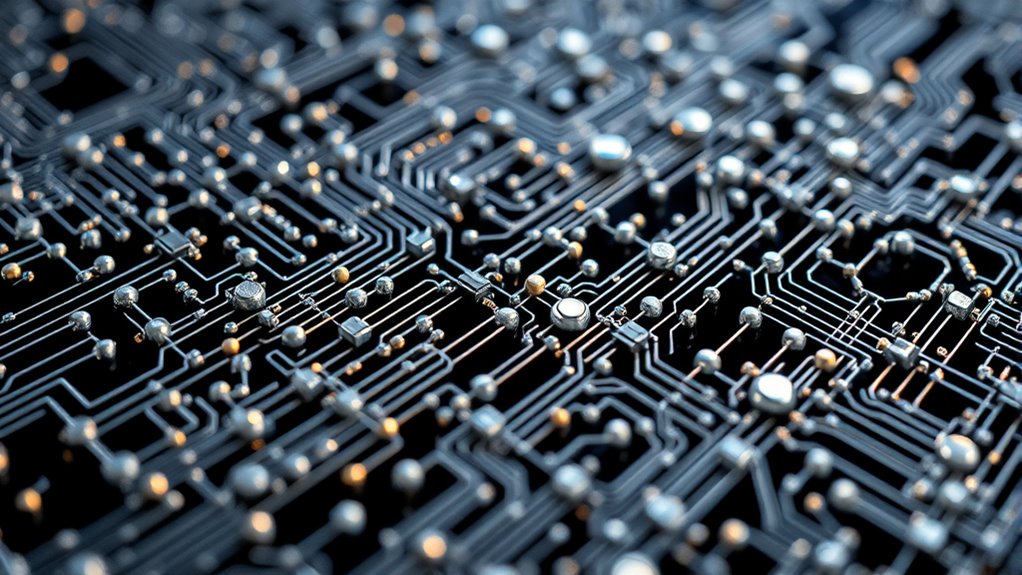
You can see how DNA-based logic circuits perform computations using molecular interactions, making them highly precise at the nanoscale. Quantum dot logic devices leverage light and electron properties to create switchable logic functions in tiny spaces. Exploring these implementations reveals the innovative ways nanomachines process information on an incredibly small scale. Detecting passive voice can help improve the clarity and effectiveness of descriptions in these advanced technologies.
DNA-Based Logic Circuits
DNA-based logic circuits harness the natural properties of DNA molecules to perform computational functions at the nanoscale. By designing specific sequences, you can create logic gates that respond to molecular inputs, enabling complex decision-making. In synthetic biology, researchers leverage DNA’s programmability to develop these circuits efficiently. Enzyme engineering plays a vital role, as enzymes can catalyze reactions that switch DNA states, acting as nanoscale switches.
- You can integrate multiple gates for more complex operations.
- DNA’s biocompatibility allows in vivo applications.
- These circuits are highly customizable through sequence design.
This approach offers a versatile platform for nanoscale computing, advancing biosensing, diagnostics, and nanorobotics. You can harness natural DNA behaviors combined with synthetic biology techniques for innovative, functional nanomachines.
Quantum Dot Logic Devices
Building on the concept of molecular logic circuits, quantum dot technology offers a powerful platform for nanoscale logic gate implementation. Quantum confinement allows electrons within quantum dots to have discrete energy levels, enabling precise control over exciton dynamics. These excitons—electron-hole pairs—are key to switching behaviors in quantum dot devices. By manipulating light or electrical signals, you can control exciton formation and recombination, forming the basis of logic operations at the nanoscale.
| Quantum Dot Features | Logic Functionality |
|---|---|
| Quantum confinement effects | Enables discrete, tunable energy states |
| Exciton dynamics | Facilitates fast, controllable switching |
| Size-dependent properties | Allows customization of logic responses |
Challenges in Nanoscale Logic Circuit Design
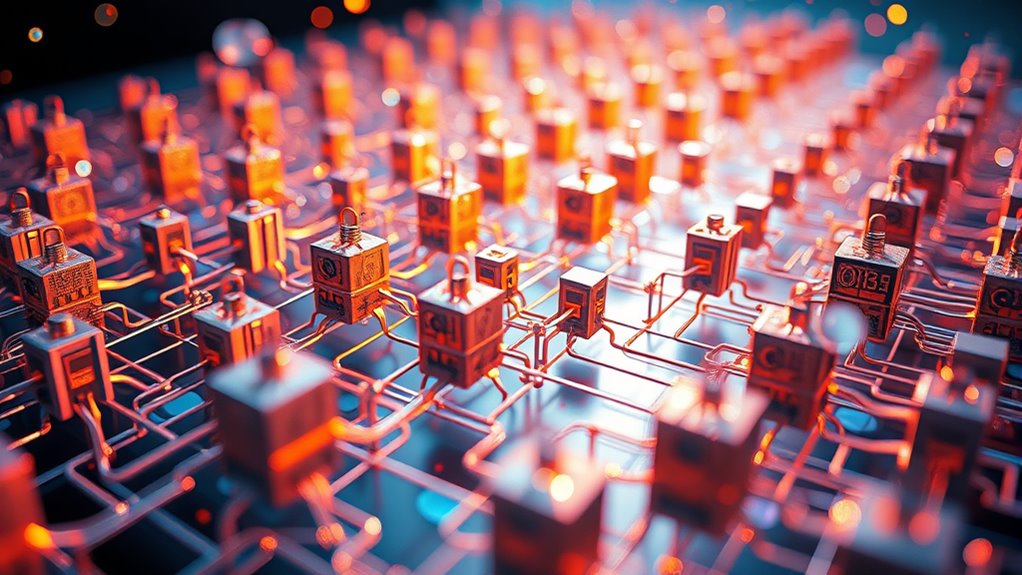
Designing logic circuits at the nanoscale presents significant challenges, primarily because traditional electronic principles often break down as components shrink to atomic dimensions. Scaling limitations make it difficult to maintain reliable performance, as quantum effects and electron tunneling become prominent. Fabrication complexities also increase, requiring precise control to create consistent, defect-free nanostructures. These issues lead to variability and reduced yield in production. Additionally, heat dissipation and signal interference at such small scales pose further hurdles. You must navigate these obstacles while ensuring circuit stability and efficiency. Overcoming these challenges demands innovative approaches in materials, techniques, and design methodologies. Without addressing these key issues, developing scalable, functional nanoscale logic circuits remains an ongoing struggle. Understanding quantum effects is crucial for advancing nanoscale circuit design and overcoming these fundamental limitations.
Potential Applications of Programmable Nanomachines
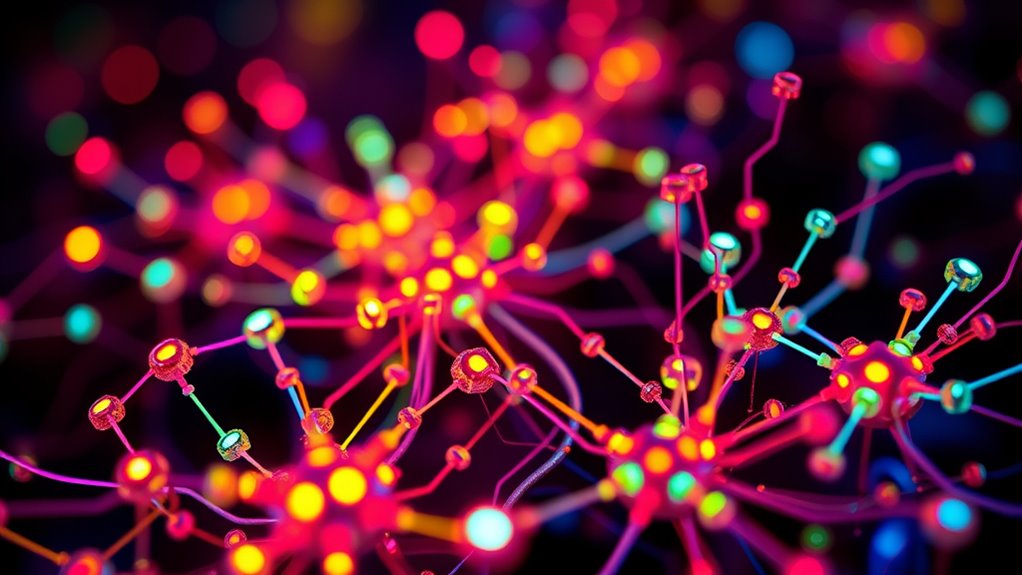
Programmable nanomachines could revolutionize medical diagnostics by detecting diseases at the cellular level quickly and accurately. They also hold promise for environmental cleanup, targeting pollutants directly and breaking them down efficiently. Exploring these applications shows how nanotechnology can address some of the biggest challenges we face today. Additionally, understanding fetal development during pregnancy can guide innovations in prenatal care and diagnostics.
Medical Diagnostics Advancements
Advancements in nanotechnology are transforming medical diagnostics by enabling programmable nanomachines to detect diseases with unprecedented accuracy. These nanomachines utilize molecular communication to relay information within the body, providing real-time insights into disease markers. They can harvest energy from their environment, eliminating the need for external power sources, which allows for continuous operation inside the body. This innovation improves early detection and monitoring of conditions like cancer or infections. Additionally, nanomachines can be designed to target specific cells, increasing diagnostic precision.
- They identify biomarkers through selective molecular interactions
- Use energy harvesting to operate autonomously over extended periods
- Communicate findings internally via molecular signals for rapid analysis
Environmental Cleanup Solutions
Nanomachines hold great promise for environmental cleanup by actively seeking out and neutralizing pollutants. With advanced pollutant detection capabilities, they can identify harmful chemicals precisely where they are, enabling targeted responses. These nanomachines can implement bioremediation strategies more efficiently, breaking down contaminants at the source and reducing environmental impact. Unlike traditional methods, programmable nanomachines can adapt to different pollutants, making cleanup efforts more versatile. They can also work continuously, monitoring ecosystems and performing cleanup without human intervention. By integrating sensors and logic gates, these devices can autonomously decide when and how to act, ensuring ideal pollutant removal. This combination of detection and active remediation positions nanomachines as a transformative solution for tackling environmental pollution sustainably.
Future Directions in Nanoscale Computing and Control
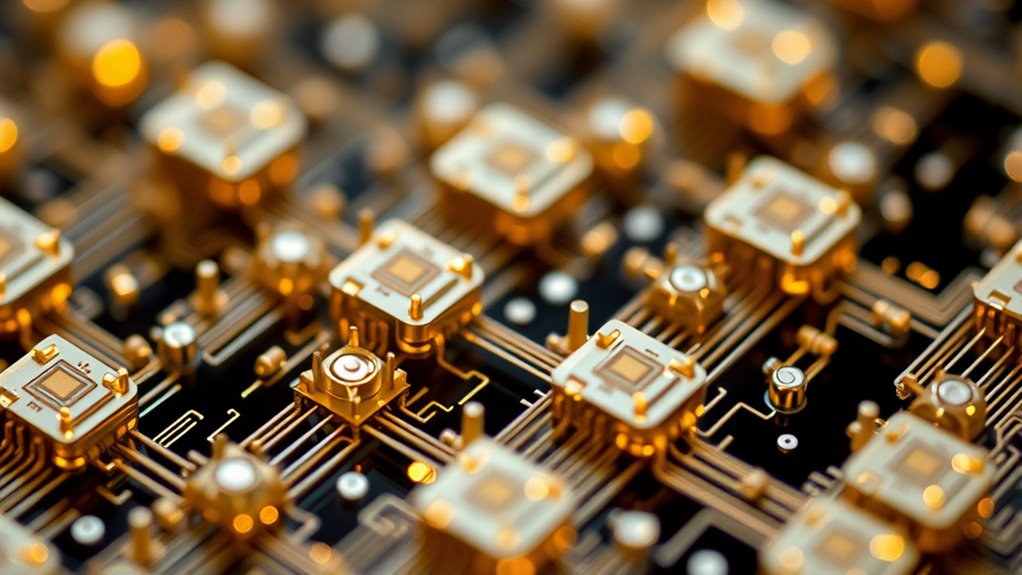
As researchers continue to push the boundaries of nanoscale computing, the potential for highly sophisticated control systems becomes increasingly tangible. Advances in molecular memory will enable nanomachines to store and retrieve data efficiently, boosting their autonomy. Nanoscale robotics will evolve, allowing for more precise manipulation and complex tasks within biological and environmental contexts. Future developments may include integrated control architectures that combine logic gates with molecular memory for real-time decision-making. These innovations could lead to highly adaptive nanodevices capable of self-repair and dynamic responses. You’ll likely see a focus on scalable manufacturing techniques to produce complex nanosystems reliably. Additionally, hybrid systems combining biological components with synthetic nanomachines will open new frontiers in medicine and environmental management.
Frequently Asked Questions
How Do Nanomachines Communicate With Each Other at the Nanoscale?
Imagine tiny messengers passing glowing signals through a bustling network. You see, nanomachines communicate via molecular signaling, where molecules serve as messages that trigger responses. Sometimes, they utilize quantum tunneling, allowing particles to leap between nanomachines instantly. This combination lets your nanomachines exchange information efficiently at the nanoscale, enabling complex coordination and tasks without bulky hardware, all happening in a dance of atoms and particles.
What Are the Energy Consumption Considerations for Nanoscale Logic Gates?
You need to prioritize power efficiency when designing nanoscale logic gates, as they consume minimal energy but still generate heat. Efficient energy use reduces heat dissipation, preventing overheating and ensuring stable operation. By optimizing materials and switching mechanisms, you can lower energy consumption, improve performance, and extend the lifespan of nanomachines. Careful management of power and heat is essential for reliable and scalable nanoscale computing systems.
How Scalable Are Current Nanomachine Programming Techniques?
Scaling nanomachine programming is like building with tiny Lego blocks—challenging but possible. You face scalability challenges because current techniques struggle to efficiently produce and assemble nanodevices at larger scales. Manufacturing limitations, such as precision and consistency, hinder mass deployment. While progress is steady, expanding these methods requires overcoming both technical hurdles and material constraints, making widespread application a gradual process.
What Are Potential Environmental Impacts of Deploying Nanomachines?
You should be aware that deploying nanomachines could lead to environmental toxicity if they release harmful substances or accumulate in ecosystems. Bioaccumulation concerns might arise if nanomachines persist in biological systems, potentially harming wildlife and humans. To minimize these impacts, you need to develop biodegradable and environmentally safe nanomachines, ensuring strict regulation and thorough testing before deployment, so the benefits don’t come at the expense of ecological health.
How Do Error Rates Affect Nanoscale Logic Circuit Reliability?
Error rates considerably impact the reliability of nanoscale logic circuits. If errors occur frequently, you need robust error correction and fault tolerance strategies to maintain proper function. Implementing redundancy and dynamic error detection helps you identify and fix faults quickly, ensuring your nanomachines operate accurately. Without these measures, high error rates could lead to system failures or unpredictable behaviors, undermining the benefits of nanotechnology at such small scales.
Conclusion
As you navigate the tiny universe of nanomachines, remember you’re crafting the building blocks of tomorrow’s technology. Like masters of a microscopic orchestra, you set the stage for incredible innovations—logic gates at the nanoscale—transforming dreams into reality. With every breakthrough, you’re weaving a future where machines dance at the tiniest level, revealing endless possibilities. Keep pushing the boundaries; your work is the spark igniting the next wave of nanotechnological marvels.


